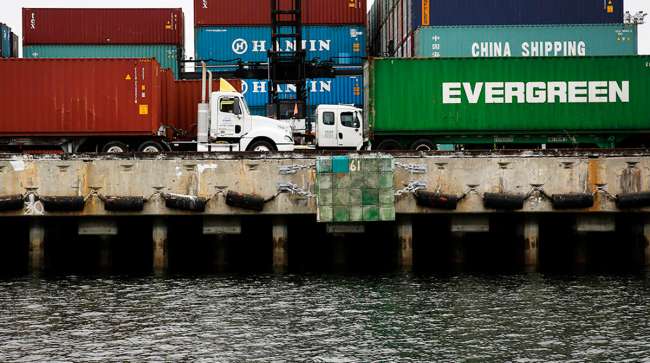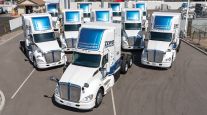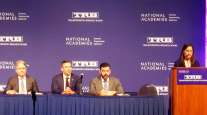Senior Reporter
Calif. Ports Clean Air Plan Calls for Zero-Emissions Trucks

The ports of Los Angeles and Long Beach released their proposed 2017 Clean Air Action Plan Update, which calls for zero-emissions trucks, increased use of rail for outbound cargo and support for alternative fuels.
The two ports form the nation’s busiest harbor complex and together handle about 40% of the nation’s total containerized import traffic and 25% of its total exports, according to port administrators. They also are located in a region with some of the nation’s worst air quality.
The ports launched their initial Clean Air Action Plan in 2006. The latest version is meant to address “the enormous challenges” of reducing harmful emissions from port-related sources: ships, trucks, cargo-handling equipment, locomotives and harbor craft. The cost of implementing the 2017 plan update is estimated at $7 billion to $14 billion, the ports said.
“These ports are going where no port has gone before,” Port of Los Angeles Executive Director Gene Seroka said in a statement. “Based on what we’ve already accomplished to promote healthy, robust trade through our gateway, we’re ready to make history again, looking at a new array of technologies and strategies to further lower port-related emissions in the decades ahead.”
The plan outlines near-term and long-term strategies:
- Starting in 2018, phase in clean engine standards for new trucks entering the port drayage registries.
- Set up a truck rate structure that encourages the use of near-zero and zero-emissions trucks, with the goal of transitioning to a zero-emissions drayage fleet by 2035.
- Develop a universal truck appointment system for the entire complex, with the goal of minimizing truck turn times.
- Expand the use of on-dock rail, with the long-term goal of moving 50% of all inbound cargo leaving the ports by rail. Rail currently accounts for about 33% of the outbound cargo, a port official said.
- Update the Vessel Speed Reduction Program, which encourages approaching ships to reduce emissions by going slower, expand the use of state-approved alternative technologies to reduce at-berth emissions and encourage clean technology upgrades on ships to attract the cleanest vessels to the San Pedro Bay ports.
“It’s important for industry to know the ports will affect change in a way that keeps those industries economically viable,” Lee Peterson, Port of Long Beach media relations specialist, told Transport Topics. “It’s not just about cleaner air but also getting cargo through, and creating jobs so business can proper and thrive here.”
At the same time, the plan updates its clean air goals to focus on reducing greenhouse gas emissions by 40% below 1990 levels by 2030 and by 80% below 1990 levels by 2050, according to the ports. It also carries over previous 2023 targets for cutting other primary pollutants aimed at reducing diesel particulate matter by 77%, sulfur oxides by 93% and nitrogen oxides by 59% below 2005 levels.
The California Natural Gas Vehicle Coalition, in a statement reacting to the action plan, urged the ports to choose off-the-shelf, proven technology.
“These reductions can be achieved with accelerated deployment of low NOx trucks powered by renewable natural gas that reduce air pollutants by over 90% and greenhouse gases by over 70%. This technology is available today and can be used to completely upgrade the port truck fleet by 2023,” according to the statement.
The ports are agnostic on the most appropriate technology, such as hydrogen fuel cells or electrified vehicles and equipment or natural gas to achieve cleaner air, Phillip Sanfield, director of media relations for the Port of Los Angeles, told Transport Topics. “At this point, I don’t know that we have rejected any strategy.”
The update follows recent meetings with more than 50 community groups as well as “dozens and dozens” of comments from the business community, he said.
The next round of input is “an evolution of the process; rinse and repeat,” he said.
The action plan also aligns with the California Sustainable Freight Action Plan adopted in 2016 and the aggressive joint zero-emissions initiatives announced in early June by Los Angeles Mayor Eric Garcetti and Long Beach Mayor Robert Garcia, according to port officials.
The document’s release July 19 kicked off a public review and comment period that extends through Sept. 18. Written comments may be submitted to CAAP@cleanairactionplan.org.
The ports have scheduled an Aug. 30 public workshop in Wilmington, Calif., an adjacent neighborhood. Harbor commissioners from both ports plan a joint public meeting in November to consider the final draft.




